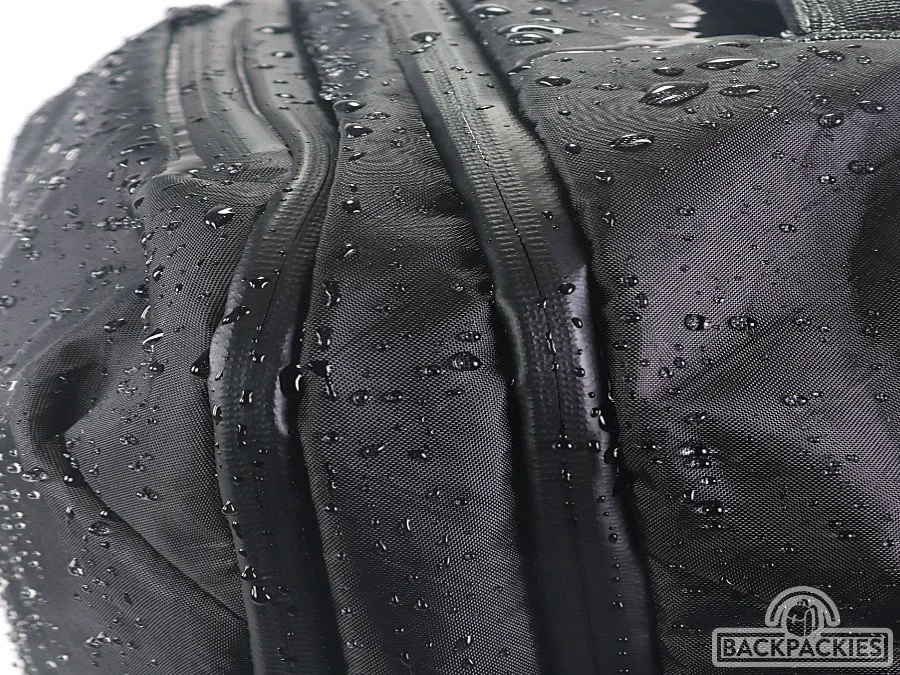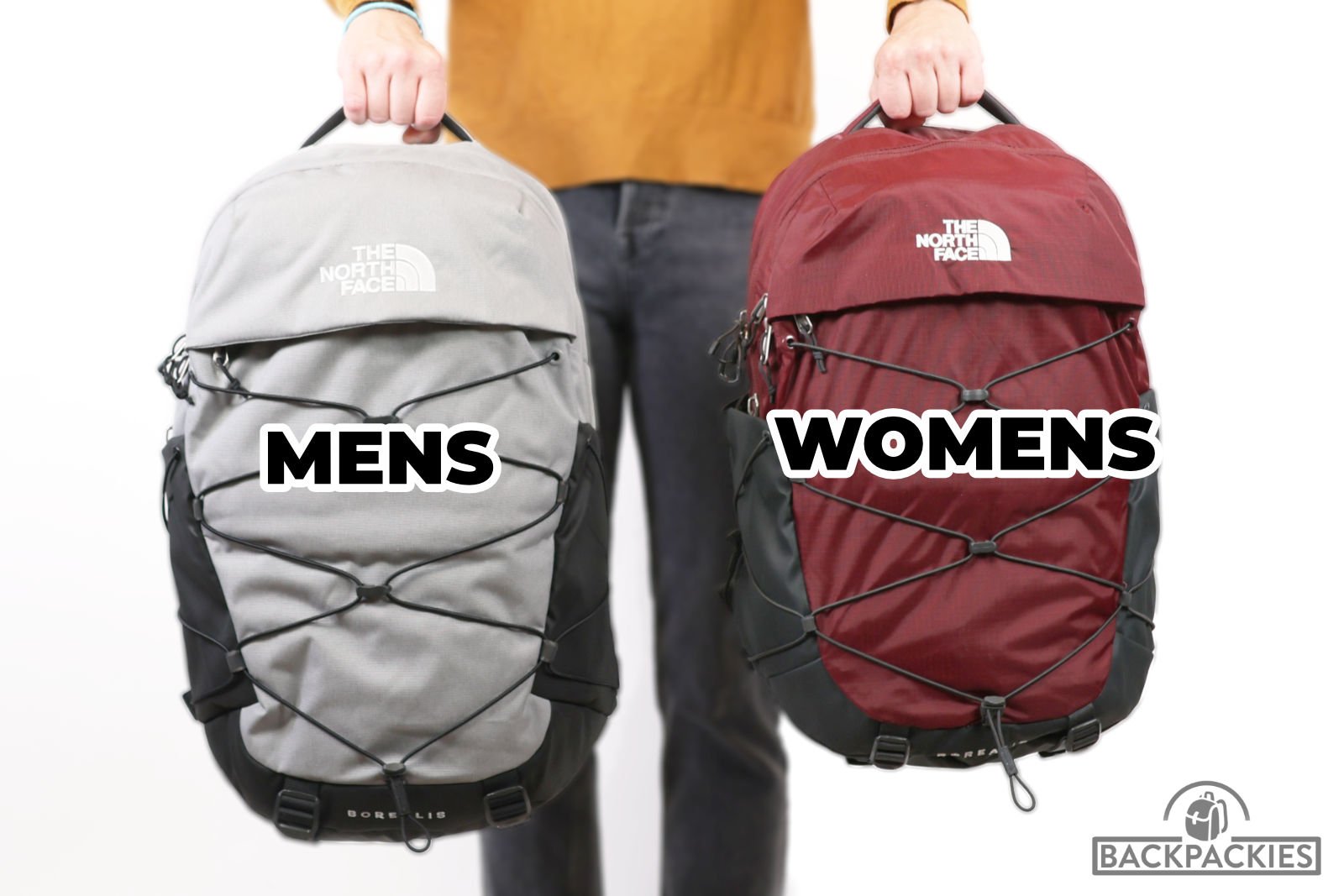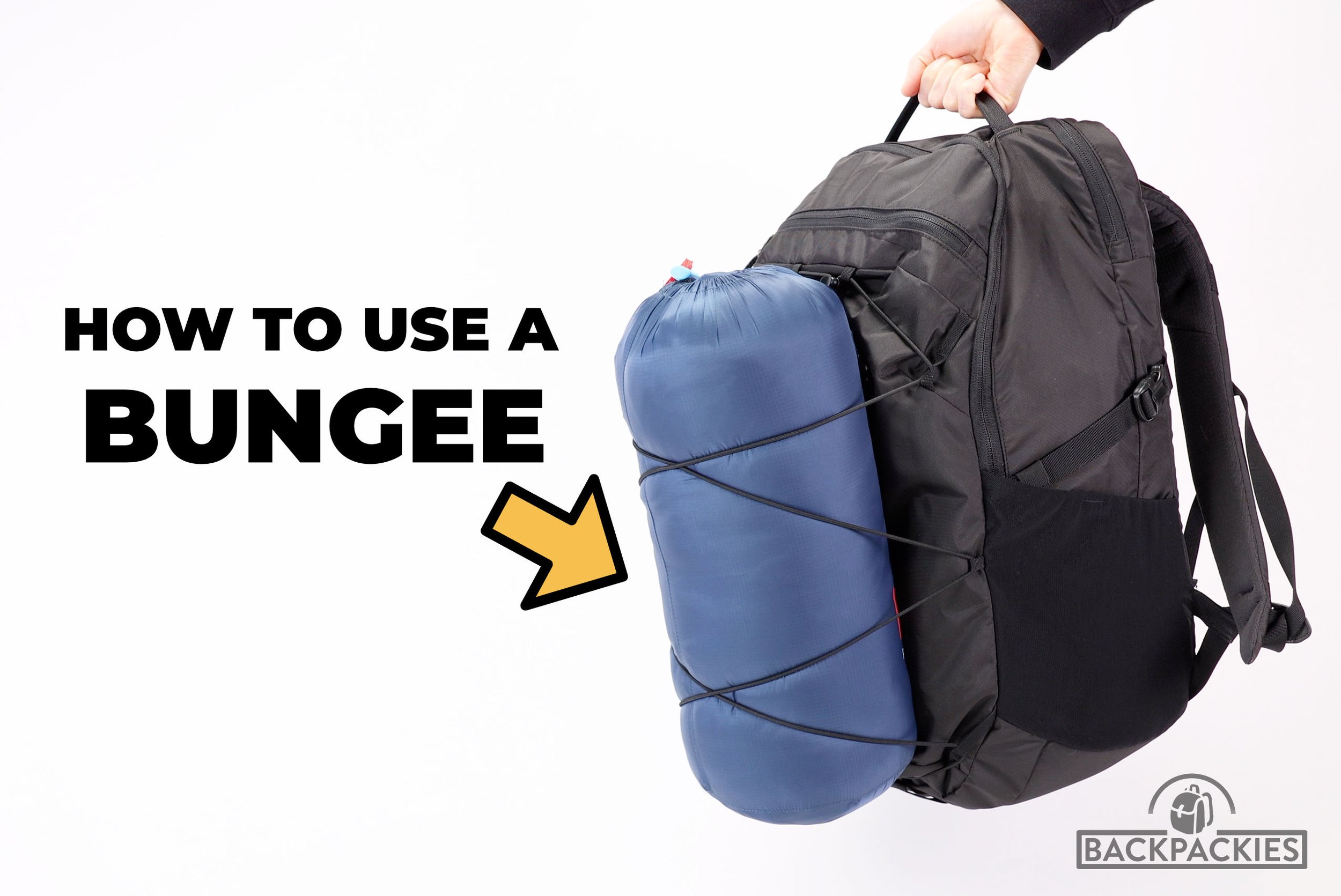Ultimate Guide to Waterproof Backpacks - Which Level Do You Need?
Water repellent? Weatherproof? DWR coating? IPX Rating?
Have you ever wondered what all of these terms mean? Then this guide is for you.
Over the years, we've tested hundreds of backpacks and realized that determining their true level of waterproofness can be tricky. Often, there's a lot of marketing jargon that ends up more confusing than clarifying.
This guide aims to simplify the world of water-resistant and waterproof backpacks for you. To make it easy, we have divided them into four categories, starting with basic water resistant backpacks (Level 1) and building up to a real waterproof backpack (Level 4).
Whether you're looking for a water-resistant backpack for college or a bag to keep your gear dry on a kayaking adventure, by the end of this guide, you'll be a pro at picking out the perfect backpack for your needs.
Water Resistant vs Waterproof backpack. Which level do you need?
Table of Contents
Level 1 - Water Resistant Backpacks
Key Takeaways:
Level 1 water resistant backpacks are best for protection against light rain and snow flurries
Some backpack fabrics will have a water repellent coating that allows water to bead up and roll off the fabric before penetrating. DWR (durable water repellent) is a popular water repellent fabric treatment.
Backpacks at this level have two main weak points where water can sneak in: zippers and seams
Look for design features such as zipper guards, backpack lids and offset zippers to increase protection against rain
Water beads - Example of water repellent DWR finish on The North Face Borealis backpack
Water resistant vs Water Repellent
You will often see the term ‘water repellent’ when browsing different backpacks. Let’s explain what that means.
With backpacks, water repellent is referring to a special coating on the fabric that actively repels water away from the surface. A common type of water repellent finish is DWR (durable water repellent), which is added to the exterior fabric of many backpacks. You can tell when a fabric is treated with DWR because the water will bead up and roll off the fabric before it gets a chance to penetrate.
The difference between "water resistant" and "water repellent" is simple:
Water resistant fabric slows down water penetration but won't completely prevent it over time. This level of protection is great if you are caught in a brief, light rain, but prolonged exposure to rain will cause trouble.
Water repellent fabric will allow water to form beads and roll off the surface, offering better protection against prolonged rain exposure. But it's important to understand that water repellent fabric still isn't waterproof, as you'll see below.
Weak Points: Zippers and Seams
Although many backpack fabrics are treated with water repellent coatings, this still does not make a backpack waterproof. In fact, it’s not even close.
Level 1 water resistant backpacks have two huge weak points where water can penetrate: zippers and seams.
Regular fabric zippers and stitched seams are weak points for leaking in backpacks
Water can sneak in through the zipper teeth and stitching. To make matters worse, most zippers face upward and come into direct contact with rain when you wear the backpack, putting the contents inside at risk of water damage.
Have you ever taken a close look at backpack seams? If you have, you may have noticed tiny holes and gaps where the two backpack panels have been stitched together. These little holes are another weak point where water loves to sneak in.
Unfortunately, even if a backpack's fabric has been treated with a water-repellent finish, water will find a way inside through zippers and seams if exposed to rain long enough, increasing the risk of water damage.
Features That Make A Backpack More Water Resistant
Given that most backpacks offer only basic water-resistant protection, it helps to know which design features can help keep your items safe from rain.
Zipper Rain Guards - Zipper guards are strips of fabric that cover the zippers to protect them from the elements. It’s a great feature to look out for because zippers are often where leaks start.
Backpack Lids - A backpack lid is a flap that covers the top of the backpack to create a barrier between the main compartment opening and the elements. A lid will always give you more protection than an exposed zipper. We have a list of our favorite flap backpacks if you are interested.
Off-Center Zippers - Backpack zippers typically open from the top, exposing them directly to rain. An off-center zipper avoids this problem by staying clear of that center line and not giving water a chance to directly splash onto the zipper when it rains.
Level 1 Water Resistant Backpack Examples
Pacsafe Go 25L Anti-Theft Backpack
The Pacsafe Go backpack is a great example of zipper rain guards done correctly. Pacsafe has added rain guards to the exterior zipper to prevent rain drops from directly hitting the zipper lines. Add a water resistant coating to the fabric and you have a very reliable water resistant backpack for travel and daily use! Check out our Pacsafe Go backpack review for an in-depth look.
Topo Designs Rover Pack
The Topo Designs Rover Pack is a good example of a water-resistant backpack that uses a lid design for extra weather protection. The pack itself is made from a water-resistant packcloth fabric, and the lid covers the opening to the main compartment to create an extra layer of protection. Side compression straps and an adjustable chest strap make the Rover Pack a great option for daily use and hiking alike. It's simple design details like this that make all the difference when looking for a backpack that can handle a light shower.
Patagonia Black Hole Backpack
The Patagonia Black Hole backpack is made with recycled polyester ripstop with a TPU-film laminate; a water repellent fabric that allows water to bead up on the surface and roll away. Although the zippers are not water resistant, this backpack is a great example of offset zippers. Instead of facing upwards, the zippers are at a slight slant to prevent rain from hitting them directly. Check out our Patagonia Black Hole 25L vs 32L comparison to learn the differences between the different sizes.
Level 2 - Highly Water Resistant Backpacks
Key Takeaways:
Level 2 ‘highly water-resistant’ backpacks introduce elements like water resistant zippers and advanced technical fabrics that are more protective against rain.
Highly water-resistant backpacks are ideal for urban commuters and travelers who face prolonged exposure to rain. Most people don’t need more than this level of protection.
These backpacks are still not fully waterproof due to weak points like regular stitching at the seams, limiting their protection in situations where the bag can be soaked or drenched.
Marketing terms such as "weatherproof" or "weather-resistant" are commonly used to describe these backpacks, reflecting their enhanced but not complete waterproof protection.
WATER RESISTANT ZIPPERS
Unlike the regular zippers used in most backpacks, water resistant zippers are designed to prevent water from sneaking in through the zipper line.
The most common water resistant zippers you'll find are YKK Aquaguard Zippers. These can be easily identified by their shiny black appearance, which comes from the polyurethane coating covering the zipper teeth.
Example of water resistant zippers - Tortuga Travel Backpack Pro 40L
Some backpacks may use fabric YKK RC zippers that are coated with a DWR coating to make them water repellent. These can be tough to identify because they look exactly like regular fabric zippers without a DWR coating.
Note: If a brand doesn’t specifically mention that they use water resistant zippers, then they probably aren’t.
Common fabrics Used in Highly Water Resistant Backpacks
At Level 2, it becomes standard to see backpacks made with water repellent or waterproof fabrics. Below are a few common ones but please note that this is far from a complete list.
Treated Nylon or Polyester - Many Level 2 backpacks use treated nylon or polyester for their exterior fabrics to make them water repellant. This treatment creates a surface that repels water, which, when combined with water-resistant zippers, provides great protection against rain. This will be the most common fabric for backpacks at this level.
Waxed Canvas - Cotton canvas is a natural breathable fabric that can really be beefed up in water repellency when waxed. Although not waterproof, waxed canvas does a great job at allowing water droplets to roll away before they can do any damage. However, this material does require some upkeep; you'll need to reapply wax periodically to keep its water-repellent coating.
X-PAC - X-PAC is a lightweight, tear-resistant and waterproof fabric that is popular with many backpack brands. You can tell it is X-Pac from the "X" lines that run throughout the fabric. Usually, X-PAC has polyester waterproof membrane that prevents water penetration. Just beware: X-Pac is a pricey fabric and backpacks that use X-Pac are typically more expensive.
EcoPak - Similar to X-PAC, Ecopak is a fabric made with a waterproof membrane but it is made with recycled materials. It's lightweight, has great UV resistance and is completely waterproof. Many higher-end backpack brands like to use EcoPak fabric because of its environmentally friendly properties and attractive matte look.
Why isn't this waterproof?
When most people talk about needing a "waterproof backpack for college" or "waterproof travel pack" they are often looking for backpacks at Level 2.
To be completely fair, most people will be fine with this level of waterproof protection, but it is still not technically waterproof. A big weak spot with these backpacks are the seams - these bags still use regular stitching. As a result, they aren't great for prolonged exposure in heavy rain or for activities on the water. For that level of protection, you'll have to move up to Level 3.
It’s worth mentioning that at Level 2, you will start to see terms like weatherproof, weather-resistant, and waterproof shell, among other marketing phrases. The reason is simple: backpack brands want to convey that there is some level of protection from wet conditions, but they cannot claim these backpacks are "waterproof" because they are not.
Level 2 ‘Highly Water Resistant’ Backpack Examples
Alpaka Elements Backpack Pro
The Alpaka Elements Pro is a laptop backpack made with a waterproof X-Pac fabric shell and features coated water resistant zippers to protect against moisture. This backpack is a great example of how high-quality materials can provide weather protection for expensive electronics and personal items, shielding them from wet weather conditions. Its durable construction makes it ideal for students and urban commuters who often find themselves braving the elements. Check out our urban backpack buying guide for similar examples.
Rains RollTop Rucksack
The Rains Rolltop Rucksack is made from Rains' own waterproof PU fabric on both the body and shoulder straps. The rolltop closure creates a natural waterproof barrier, making it highly protective against rain and splashes. However, since this backpack does not have waterproof seams, it falls into the ‘highly water-resistant’ category. While the Rains Rolltop Rucksack might not be the best option for outdoor adventures involving heavy water exposure, it’s a perfect example of different features coming together to create a protective rolltop backpack for keeping personal belongings dry in the rain.
Level 3 - Almost Waterproof Backpacks
Key Takeaways:
Level 3 ‘Almost Waterproof Backpacks’ introduce waterproof seams paired with waterproof fabrics, making them ideal for protection against long periods in heavy rain, large splashes and extreme conditions.
These backpacks are best for bike commuting, hiking and outdoor activities where protection from heavy rain or splashes are needed.
Although you can partially soak these backpacks, they are not airtight or designed to be fully submerged in water. These backpacks also usually do not have IP ratings (more on that later)
WATERPROOF Backpack SEAMS
No stitch holes - What sealed waterproof seams on a backpack look like
Waterproof seams on a backpack are very easy to identify once you know what they look like. Unlike regular seams, there are no small stitch holes for water to penetrate, ensuring a waterproof seal. The most common waterproof seam to look for is a welded seam.
Welded Seams Explained: Welded seams are the gold standard for waterproofing in backpacks. Instead of using traditional stitching, welded seams fuse two pieces of waterproof material together, creating a fully waterproof barrier that prevents any moisture from entering the bag.
Now, a lot of brands will add in all sorts of flair to describe their welded seams like RF (radio frequency) welded seams, high-frequency welded seams, or some other "special" welded technology. Although there are technical differences, these are all just variations of welded seams. Do yourself a favor and look past the marketing jargon.
Common Waterproof Materials
Many waterproof backpacks are crafted from synthetic materials. In fact, a lot of the materials used are just some form of plastic. These fabrics tend to be thicker and heavier than standard nylon or polyester and they feel very different as well. This is why many waterproof or “almost waterproof” backpacks can be considered excessive for the average person who wants something lightweight and easy to handle for daily carry.
Common waterproof materials include:
Laminated Fabrics: These are regular fabrics, like polyester or nylon, that are laminated with a waterproof layer. This lamination preserves the fabric’s flexible characteristics while ensuring waterproofness for enhanced protection. An example would be a fabric with a PU coating on the outside and a TPU backing on the reverse side to create a waterproof fabric.
PVC: PVC is a thick, heavy material that's completely waterproof. Combined with welded seams, PVC backpacks are among the most waterproof available on the market.
Tarpuline: Tarpuline, or tarp, is another common material used in waterproof backpacks. Just like PVC bags, tarpuline bags are mostly used for outdoor bags where a tough and waterproof exterior is needed.
Level 3 ‘Almost Waterproof’ Backpack Examples
Chrome Urban Ex Backpack
The Chrome Urban Ex backpack features welded seams and a PU coated nylon on the surface with a TPU backing to create a waterproof barrier. The rolltop also offers a great seal from rain and splashes! Made to be an urban commuter backpack, the Urban Ex offers a good balance between weather protection and internal pockets for daily items like a laptop, keys and smaller items. Although the Urban Ex is a beast against heavy rain, this backpack was not designed to be submerged in water.
Got Bag Rolltop Backpack
The Got Bag Rolltop backpack features a waterproof TPU backside and a PU face-side coating on the fabric, held together with welded seams. The Got Bag Rolltop is a jack-of-all-trades backpack designed for maximum versatility, making it ideal for harsher weather conditions. Inside, there’s a tech sleeve for daily carry that can be removed to transform the Rolltop into an outdoor adventure bag. It provides excellent protection against rain and large splashes, although it’s not airtight enough to be a submersible backpack.
Level 4 - Waterproof Backpacks
Key Takeaways:
Also known as waterproof dry bags, Level 4 ‘waterproof backpacks‘ are truly waterproof and can withstand everything from rain to submersion thanks to their airtight constructions and waterproof materials.
These heavy-duty backpacks are ideal for outdoor activities on the water such as fishing, kayaking, or white-water rafting, ensuring that your dry gear stays protected.
Here we finally introduce waterproof zippers to ensure an airtight seal, although roll-top constructions are more common.
Waterproof backpacks utilize heavy-weight coated or synthetic materials, often plastic-based, to achieve waterproofing. The weighty nature of these materials makes these backpacks less than ideal for daily use.
Waterproof Zippers
Unlike water resistant zippers, waterproof zippers create an airtight seal when zipped shut. You can tell a zipper is waterproof if you're unable to squeeze any air out of the backpack once it's zipped closed.
A common waterproof zipper is the YKK Aquaseal zipper. These zippers are easy to spot because they have massive teeth that are made out of plastic, making them great for saltwater environments.
However, we generally don't recommend backpacks with waterproof zippers for everyday use because they're not as smooth to operate as regular zippers. They require more effort to open and close due to the airtight seal. Moreover, waterproof zippers have to be regularly lubricated to maintain their waterproof performance. Trust us, they are more trouble than they are worth if you are just looking for a daily laptop backpack.
YKK Aquaseal Waterproof Backpack Zipper on the Breakwater Supply Fogland Backpack
Backpack IP Ratings Explained
To skip the marketing terms and determine the true waterproofness of a backpack, you can use the IP rating system as a guide. IP ratings are often used for waterproof products such as electronic devices and waterproof clothing, but it also can be used for bags. We are going to keep this explanation as simple as possible to make it easy.
IP stands for Ingress Protection. This rating determines how resistant the pack is to dust and water. The first number in the IP rating is for dust protection (0-6) while the second number stands for how protective the backpack is against water (0-8). Some backpack brands skip the dust protection test and you will see an X over where the dust protection number normally is.
IP Rating Examples:
IP68 - this backpack has a dust protection number of 6 and a water protection number of 8
IPX7 - this backpack does not have a dust protection number (X) but has a water protection number of 7
Although dust protection is great, the important number on a waterproof backpack will always be the second water protection number. Again, an X will mark the absence of a dust protection rating.
IP Ratings Guide for Backpacks:
IPX1 to IPX4 = Just a water resistant backpack with some protection
IPX5 or IPX6 = Waterproof backpack that is not airtight and may let water in if fully submerged underwater
IPX7 or IPX8 = Waterproof backpack that is airtight and can be completely submerged underwater
If you are looking for a true waterproof backpack that can be submerged in water, then look for an IP rating of 7 or 8.
Level 4 Waterproof Backpack Examples
Breakwater Supply Fogland Backpack
Looking for the best waterproof backpack for outdoor activities but not a big fan of rolltop closures? Check out the Breakwater Supply Fogland Backpack. It uses a laminated Nylon TPU fabric that is held together with welded seams - creating the perfect waterproof fabric and seams combo. The top zipper is also a true waterproof zipper that provides an airtight seal when closed. Not only can the Fogland float on water, but it's also a submersible backpack thanks to its IP68 waterproof rating - the highest IP rating a waterproof backpack can get.
Expedition / Units Project 8020 Backpack
The Expedition / Units Project 8020 Backpack is made from heavy-duty laminated TPU-coated waterproof fabric paired with welded seams for maximum waterproof protection. With an IPX5 rating, this backpack can handle splashes of water from all angles and will float on water when properly sealed. This is a great example of a do-it-all dry bag for outdoor activities on the water, featuring interior pockets for organization and fast-drying shoulder straps. Small features like attachment points and a water-resistant external pocket provide quick access to accessories.
Cheat Code: How to Make A backpack waterproof
What if we told you that there was a simple, affordable and effective way to add instant waterproof protection to any backpack?
Luckily, there is and it’s called a rain cover.
Rain covers have long been the unsung heroes of hiking backpacks, offering an instant waterproof upgrade for a small investment. Some backpacks will include a rain cover but aftermarket generic ones are also available online.
In conclusion, while exploring the various levels of waterproof bags, consider how and where you'll use your backpack most frequently. For those seeking an everyday pack that doesn't sacrifice important features, combining a basic water resistant backpack with a rain cover might be the perfect compromise.
Whether braving urban downpours or embarking on outdoor adventures, choosing the right level of waterproof protection will ensure your belongings are safe and dry, no matter the conditions.
More Helpful Resources
Best Waterproof Backpacks for College - Our favorite water-resistant and waterproof backpacks for students
Best Roll Top Waterproof Backpacks - From laptop backpacks to outdoor workhorses; our top waterproof roll tops
Best Waterproof Backpacks for Women - The best waterproof and water-resistant backpacks that accommodate smaller shoulders and torsos.





















